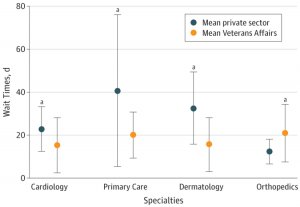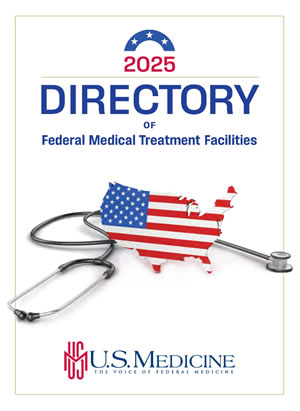WASHINGTON—Five years after scandal rocked the VA, the agency still does not have a reliable way of tracking patient wait times according to a recent Government Accountability Office report.
In 2014, whistleblowers at the Phoenix VAMC revealed that facility leadership was fraudulently lowering veteran wait-time data, sometimes by several months. Investigations determined that more than 200 veterans died while waiting for care in Phoenix and that wait-list backlogs were a problem throughout VA. The scandal made national headlines, the effects of which are still reverberating.
Testifying before the House VA Committee last month, Debra Draper, director of GAO’s Healthcare Team, told legislators that the VA has not met many of the recommendations the watchdog agency first made years ago in regards to improving VA wait times.

Comparison of Wait Times for New Patients Between the Private Sector and United States Department of Veterans Affairs Medical Centers
Legend: Wait Time by SpecialtyEach dot represents the mean wait time per new patient for an appointment in the private sector and Veterans Affairs facilities in 2017, stratified by specialty of care. The error bars indicate measures of uncertainty in SD. aSignificant comparison at P = .05.
(JAMA Netw Open. 2019;2(1):e187096. doi:10.1001/jamanetworkopen.2018.7096)
“We continue to be concerned that VA has not sufficiently addressed the reliability of its wait-time data,” Draper said. The GAO has recommended that VA create more consistent rules in calculating wait times, capture access delays such as initial receiving of benefits and better train schedulers.
GAO also made recommendations to improve appointment scheduling for veterans accessing non-VA providers. In June 2018, GAO found that the data VA was using to monitor the timeliness of Veterans Choice Program appointments was incomplete. Although VA had a wait-time goal of 30 days, VA’s timeliness data did not capture certain processes, such as the time taken to prepare veterans’ referrals and send them to a third-party administrator.
“GAO found that if these were accounted for, veterans could potentially wait up to 70 days to see a provider,” Draper explained.
According to VA officials, most of these issues will be resolved with the rollout of its new scheduling system, which is expected to be up and running in VA facilities by fiscal year 2021. Draper noted, however, that the new technology will only be as good as VA oversight and employee training.
“The schedulers are among the top 10 highest turnover positions in VA,” Draper explained. “It’s about educating those schedulers and making sure they’re consistently implementing scheduling policy. Oversight and accountability—we continually find pockets where it’s not very effective. I think the new scheduling system will be very helpful, but that will not solve all the problems.”
One of Several Metrics?
There’s even an argument as to how important wait times are in calculating patient experience. Kenneth Kizer, MD, MPH, VA’s under secretary for health from 1994 to 1999 and now the chief healthcare transformation officer at Atlas Research, told committee members that wait times are critical in patient care but should only be one of several metrics used in judging VA’s effectiveness.
“While assuring timely access to care is widely recognized as an important dimension of quality healthcare, consistently achieving timely access to care continues to be a challenge throughout American healthcare,” Kizer explained. “Long wait times for care are all too common for patients and families everywhere, especially those on publicly funded insurance. When patients have to wait weeks or months to see a physician, bad things tend to happen.”
Thinking of access solely in terms of wait times is turning a multidimensional issue into a unidimensional one, he argued.
“Wait times technically turn out to be exceedingly difficult to capture. And even if wait times are accurately measured, they’re just one dimension of looking at access,” Kizer suggested. “When considering timeliness of care and how accessibility of care should be measured, we need to ask a basic and fundamental question of what access to care means in an era of enhanced connectivity—communication technologies that exist today that 10 to 20 years ago were simply not available.”
While VA is a leader in telehealth, Kizer said he believed the department has “barely scratched the surface of what could be done to enhance access to care.”
According to VA leaders, the problems discovered in Phoenix have been resolved and current issues surrounding wait times center on technical limitations rather than employee fraud.
“We are not five years ago,” declared Teresa Boyd, DO, VA assistant deputy under secretary for health. “There are no secret wait lists. What we have are tools that are somewhat obsolete in their tracking capabilities and that can be misinterpreted. They don’t fit into the mold of what we said five years ago, which truly were wait lists. We don’t need to go back and relitigate that. I think we’re on a good path forward.”
She did not deny that the current potential for fraud when it comes to hiding or masking wait times, however. Asked what VA is doing to identify and curtail the practice, Boyd said that it starts with changing the culture at VA facilities and wants to encourage future whistleblowers to come forward.
“One of the first things I do is meet with various staff—a town hall of front-line staff. I don’t want leadership there. I don’t want supervisors there. Is there a good culture there? If there’s a problem I will raise my hand and stop the line. No process is perfect. We want people to poke holes in it.”


